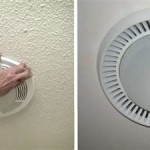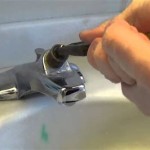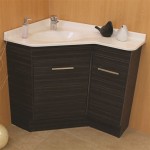How To Replace an Outdoor Bathroom Vent Cover
Outdoor bathroom vent covers play a crucial role in maintaining the air quality and structural integrity of a home. They are designed to allow moist air from the bathroom to escape, preventing mold growth, mildew, and potential damage to building materials. Over time, however, these vent covers can become damaged, deteriorated, or simply aesthetically unappealing. Replacing a vent cover is a relatively straightforward home improvement project that can be accomplished by most homeowners with basic tools and a little know-how. This article provides a comprehensive guide on how to replace an outdoor bathroom vent cover, ensuring proper ventilation and a more appealing exterior appearance.
Before initiating any work, it is imperative to understand the different types of outdoor bathroom vent covers available. Familiarity with these variations will ensure that the correct replacement is selected and installed. Common types include louvered vents, which feature angled slats to prevent rain and snow from entering; hooded vents, which offer a protective hood over the opening; and soffit vents, which are installed under the eaves of the roof. The choice of vent cover depends on the existing setup, local climate conditions, and personal preferences.
Safety is paramount throughout the entire replacement process. Prior to beginning any work on the vent cover, it is crucial to disconnect the power to any nearby electrical components. This is especially important if the vent fan itself has an electrical connection. Always use a non-contact voltage tester to confirm that power is indeed shut off. Furthermore, wearing appropriate safety gear, such as safety glasses and gloves, is highly recommended. When working at heights, use a sturdy ladder that is properly positioned and secured to prevent falls. Having a helper to stabilize the ladder can further enhance safety.
Key Point 1: Preparation and Gathering Necessary Tools and Materials
Successful replacement of an outdoor bathroom vent cover hinges on thorough preparation. This involves assessing the existing vent cover, selecting a suitable replacement, and gathering the required tools and materials. Accurate measurements of the existing vent cover are essential for ensuring a proper fit with the new unit. Note the overall dimensions, the diameter of the vent opening, and the type of mounting hardware used. This information will guide the selection of a replacement vent cover with compatible specifications. When purchasing a new vent cover, consider factors such as material (plastic, metal, or a combination), durability, weather resistance, and aesthetic appeal.
The following tools and materials are typically needed for replacing an outdoor bathroom vent cover:
- New outdoor bathroom vent cover (of the appropriate size and type)
- Screwdriver (Phillips head and/or flathead, depending on the existing fasteners)
- Drill with appropriate drill bits (for removing stubborn screws or drilling new pilot holes)
- Utility knife or caulk remover (for removing old caulk or sealant)
- Caulk gun and exterior-grade caulk (for sealing the new vent cover)
- Measuring tape
- Pencil or marker
- Safety glasses
- Gloves
- Ladder (if the vent cover is located at a height)
- Non-contact voltage tester
- Cleaning supplies (brush, cloth, cleaning solution)
Before starting the removal process, it is advisable to inspect the area around the existing vent cover for any signs of damage, such as rot, cracks, or loose siding. Addressing these issues prior to installing the new vent cover will ensure a more secure and weatherproof installation.
Key Point 2: Removing the Old Vent Cover
The removal of the old vent cover requires careful attention to avoid damaging the surrounding siding or building materials. Begin by carefully examining how the existing vent cover is attached. Most vent covers are secured with screws, nails, or caulk. If screws or nails are used, use a screwdriver or drill to remove them. If the fasteners are rusted or stripped, applying penetrating oil may help loosen them. In some cases, the vent cover may be adhered to the surface with caulk or sealant. Use a utility knife or caulk remover to carefully cut through the caulk bead, separating the vent cover from the wall.
Once the fasteners and caulk are removed, gently pry the vent cover away from the wall. If the vent cover is stuck, avoid using excessive force, as this could damage the underlying siding. Instead, gently work around the edges of the vent cover with a putty knife or flat blade screwdriver to loosen it gradually. Once the vent cover is removed, thoroughly clean the area around the vent opening. Remove any remaining caulk, debris, or dirt. Inspect the vent duct for any blockages or damage and address them accordingly. A clean and clear vent duct will ensure proper airflow.
Dispose of the old vent cover properly. Depending on the material, it may be recyclable or require disposal as construction waste.
Key Point 3: Installing the New Vent Cover
With the old vent cover removed and surrounding area cleaned, the installation of the new vent cover can proceed. Position the new vent cover over the vent opening, ensuring that it is properly aligned. Use a measuring tape to verify that the vent cover is centered and level. Using a pencil or marker, trace the outline of the vent cover onto the wall. This will serve as a guide for applying caulk and drilling pilot holes, if necessary.
Apply a bead of exterior-grade caulk around the perimeter of the vent opening, following the outline traced earlier. The caulk should be applied evenly and consistently to create a weatherproof seal. Position the new vent cover over the caulked area, pressing it firmly against the wall. Align the mounting holes in the vent cover with the existing holes or pilot holes, if applicable. If new pilot holes are required, use a drill with an appropriately sized drill bit to create them.
Secure the vent cover to the wall using screws or nails. Ensure that the fasteners are of the correct length and type for the material of the vent cover and the underlying wall. Tighten the fasteners securely, but avoid over-tightening, as this could damage the vent cover or the wall. Once the vent cover is securely attached, inspect the caulk seal around the perimeter. If any gaps or voids are present, apply additional caulk to fill them. Smooth the caulk bead with a finger or a damp cloth to create a clean and professional finish.
Finally, test the vent fan to ensure that it is functioning properly and that air is flowing freely through the vent cover. Observe the vent cover during operation to ensure that there are no unusual noises or vibrations. If any issues are detected, troubleshoot the problem and make any necessary adjustments. With the new vent cover installed and tested, the project is complete.
Maintenance is a crucial aspect of ensuring the long-term performance of the outdoor bathroom vent cover. Periodic inspections, at least twice a year, are recommended to identify any potential issues, such as cracks, damage, or blockages. The vent cover should be cleaned regularly to remove dirt, debris, and cobwebs that can obstruct airflow. A simple brushing or washing with soap and water is usually sufficient. If the vent cover is located in an area prone to snow or ice accumulation, ensure that it is kept clear during the winter months. Addressing any issues promptly will prevent them from escalating into more serious problems and extend the lifespan of the vent cover. Furthermore, consider applying a fresh coat of paint or sealant every few years to protect the vent cover from the elements and maintain its aesthetic appeal.

How To Replace An Exterior Vent Cover On A 2nd Story Home

How To Replace A Bathroom Exhaust Fan And Ductwork Outdoor Vent Cap Handymanhowto

Quickly Replace A Broken Dryer Vent Cover Diy Family Handyman

Air Sealing Bathroom And Kitchen Exhaust Fans Building America Solution Center

How To Replace A Bathroom Vent Step By Guide

Quickly Replace A Broken Dryer Vent Cover Diy Family Handyman

Does A Bathroom Vent Have To Vented Outside Dirt2tidy

Rat Nest In Bathroom Exhaust Fan How To Remove It Cover Exterior Vent Part 20

4 Inch Louvered Vent Cover Dryer With S Outdoor

Dryer Vent Way Outer Wall Outdoor Bathroom Temu
Related Posts







